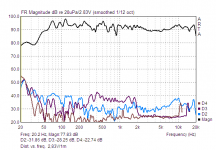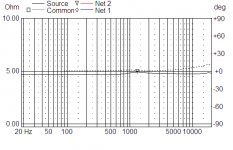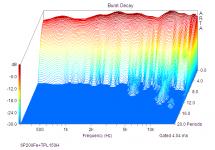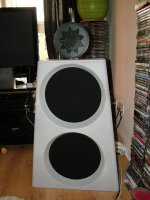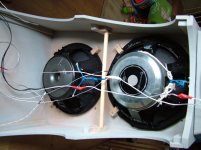With 12 inch midrange?Do you believe that?

yes, why not ?
For 3 way, I would probably use different drivers to go with the TPL150.
any suggestion ?
I have a fair deal of experience with Beyma TPL150 and TPL150H. I much prefer TPL150H with the waveguide over the standard TPL150.
1.2 kHz is too low XO for both of them if you seek ultimate performance. In my opinion 1.5 to 2 kHz is more appropriate.
Also - both drivers benefit from removing the rear chamber and felt damping pad, and let the rear side exit into a large damped chamber. THD is reduced by almost 20 dB by doing this.
I agree......I'd look towards 1.8-2khz and IMO, that's too high for the 12" Beyma to match with directivity. A 6-8" mid would be my choice here and run it down to 200hz to a 15" woofer.
I agree......I'd look towards 1.8-2khz and IMO, that's too high for the 12" Beyma to match with directivity. A 6-8" mid would be my choice here and run it down to 200hz to a 15" woofer.
The Daniel Hertz/Levinson is crossed at 1,8khz.
If there is a 8", that has such a good lower midrange, as the 12p80nd, why not use a smaller driver ?!
I like that design:
max
what i don't understand, is why they use a midrange driver, that has only 92db/wm, and is also a woofer, if there are better suited drivers with higher sensitivity, that match the tpl-150, and are dedicated midranges.
Not sure, but it was the designers choice.
For me, every design is always about the midrange and for him, maybe that little Beyma sounded just right. Whether we as DIY designers like it or not, there's MORE to speakers sound than frequency response and distortion. IMO there's things that we just can't measure and interpret.
For me, every design is always about the midrange and for him, maybe that little Beyma sounded just right. Whether we as DIY designers like it or not, there's MORE to speakers sound than frequency response and distortion. IMO there's things that we just can't measure and interpret.
Its a pity thatHawthorn audio do not sell hiw horn AMT - it can go down to 500Hz So at 800Hz for example you have much more options to mate with sensetive PRO midbasses 10-12 inches.
Hawthorne buys these from Paul Squillo :
Gallery | Paul Squillo Music Systems
i have spoken to him on the phone. He knows a guy, who builds these amt's on a diy basis - but, i was not able to buy a pair from him.
Interesting thread :
this guy likes the tpl150 with jbl 2226h better than Abbeys - Gueddes based speakers :
DIY Loudspeaker Pics
For midrange, I would really like to try the Beyma 102Nd.any suggestion ?
Not sure about the bass driver. I like the midbass from the 12P80Nd.
Still can't think of a better 2 way than 12P80Nd + TPL150H.
And there are rear loading options to get more bass.
Hawthorne buys these from Paul Squillo :
Gallery | Paul Squillo Music Systems
i have spoken to him on the phone. He knows a guy, who builds these amt's on a diy basis - but, i was not able to buy a pair from him.
Why not possible to buy?
Also, do we have measured response for that Pauls AMT? How far are highs stretched?
Because sensitivity was not main issue, 92dB/W for domestic use is (IMO) more than enough in active setup (bas-himid, passively crossed mids/highs) with more than 100 watt SS amps..what i don't understand, is why they use a midrange driver, that has only 92db/wm, and is also a woofer, if there are better suited drivers with higher sensitivity, that match the tpl-150, and are dedicated midranges.
More important is low distortion to frequencies below 100Hz, 2" voce coil, transient response ( possibility to use 6dB/okt. crossover), and smooth directivity patterns in cooperation with TPL150H,and all this at very competitive price. Result is very natural and "pleasant" sound, even at high SPL.
Attachments
Why not possible to buy?
Also, do we have measured response for that Pauls AMT? How far are highs stretched?
Well, its already a couple of years back, but for what i remember, the manufacturer was not making a regular production. He is more sort of a experimental wizzard.......
Because sensitivity was not main issue, 92dB/W for domestic use is (IMO) more than enough in active setup (bas-himid, passively crossed mids/highs) with more than 100 watt SS amps..
More important is low distortion to frequencies below 100Hz, 2" voce coil, transient response ( possibility to use 6dB/okt. crossover), and smooth directivity patterns in cooperation with TPL150H,and all this at very competitive price. Result is very natural and "pleasant" sound, even at high SPL.
hello
first of all, congratulation for your nice products. You seem to have a good luthier. As you build commercial speakers, I would try to make a wave guide for the TPL-150 of your own, its not all that difficult to curve wood, and it will look much nicer, than the standard and original Beyma wave guide. Looks soooooo ugly to me.

But the rest of the cabinet look, i like.
You do cross at 1,6khz passive. There is still a efficiency mismatch. And if you high-pass at 220hz active, what does it matter, that the midrange has low distortion below 100hz , and 2" voice coil ?
Last edited:
I wonder how badly, the crossover affects the electrical damping of the TPL.
Padding with a resistor can only make it worse.
Just thinking about the ~5ms decay at resonance.
Anyone done their own impedance measurements of the TPL?
Not sure what the conditions were when they made the impedance plot on the datasheet.
Padding with a resistor can only make it worse.
Just thinking about the ~5ms decay at resonance.
Anyone done their own impedance measurements of the TPL?
Not sure what the conditions were when they made the impedance plot on the datasheet.
Attached.. Quite pure resistive load.Anyone done their own impedance measurements of the TPL?
Nothing like resonances, look second attachment (time axis in periods..)Just thinking about the ~5ms decay at resonance.
It is very simple to use ordinary attenuation for TPL , without any degradation. In real use it is working with very low power levels, so all distortions remain very, very low (even IMD or multitone), sound is very transparent.You do cross at 1,6khz passive. There is still a efficiency mismatch. And if you high-pass at 220hz active, what does it matter, that the midrange has low distortion below 100hz , and 2" voice coil ?
Low distortion also near 100Hz for this "midrange" is important with simple 6dB/octave crossover, here is a lot of power at higher SPL. The same is valid for 2" voice coil (low power compresion) and VC with higher diameter better "supports" cone, it helps to ensure better cone stifness.
Attachments
Last edited:
Attached.. Quite pure resistive load.
It is very simple to use ordinary attenuation for TPL , without any degradation. In real use it is working with very low power levels, so all distortions remain very, very low (even IMD or multitone), sound is very transparent.
Low distortion also near 100Hz for this "midrange" is important with simple 6dB/octave crossover, here is a lot of power at higher SPL. The same is valid for 2" voice coil (low power compresion) and VC with higher diameter better "supports" cone, it helps to ensure better cone stifness.
You are using in your smaller model the 605nd. Any comment about the performance differences ?
I think the 10MI100 looks way more interesting on paper than the 6P200Fe to combine with TPL-150. Maibe someone heard it and can comment....
The BEYMA SM-115K looks interesting for bass extension below 12p80nd. It has a low Fs of 27hz, and can be used in small cabs.
Last edited:
For midrange, I would really like to try the Beyma 102Nd.
Not sure about the bass driver. I like the midbass from the 12P80Nd.
Still can't think of a better 2 way than 12P80Nd + TPL150H.
And there are rear loading options to get more bass.
I'm not so sure I agree with you here John. In your example, the drivers are forced to their operational limits.....the Beyma is really beaming at 1.5 and above and on the bottom of the TPL, high SPL listening is going to bring HD much closer to the fundamental. There's some great 6-8" midrange drivers out there, so why not explore them?
Beyma 15 inch 115K
Hi Angelo,
You mentioned the Beyma 115K...I have used a pair in various cabinets and can highly recomend it.
It is great value and runs the Precision Devices 1550 very close, and the PD is more than twice the price!
The attached show the 115K as bass with the PD 158 as low midrange, 100Hz to 400Hz.
In open baffle the Beyma and PD 1550 are almost identical below 100Hz.
If you cross over higher, up to 250Hz then the PD is cleaner and more detailed, also the PD can handle more power ( only a factor with Eq).
In a 90 litre sealed box the PD is the better bet, I run the PD 20Hz to 80Hz as corner subs. I only use them for home cinema when you want effects and expolsions rather than music.
All the best
Derek.
Hi Angelo,
You mentioned the Beyma 115K...I have used a pair in various cabinets and can highly recomend it.
It is great value and runs the Precision Devices 1550 very close, and the PD is more than twice the price!
The attached show the 115K as bass with the PD 158 as low midrange, 100Hz to 400Hz.
In open baffle the Beyma and PD 1550 are almost identical below 100Hz.
If you cross over higher, up to 250Hz then the PD is cleaner and more detailed, also the PD can handle more power ( only a factor with Eq).
In a 90 litre sealed box the PD is the better bet, I run the PD 20Hz to 80Hz as corner subs. I only use them for home cinema when you want effects and expolsions rather than music.
All the best
Derek.
Attachments
Hi Angelo,
You mentioned the Beyma 115K...I have used a pair in various cabinets and can highly recomend it.
It is great value and runs the Precision Devices 1550 very close, and the PD is more than twice the price!
The attached show the 115K as bass with the PD 158 as low midrange, 100Hz to 400Hz.
In open baffle the Beyma and PD 1550 are almost identical below 100Hz.
If you cross over higher, up to 250Hz then the PD is cleaner and more detailed, also the PD can handle more power ( only a factor with Eq).
In a 90 litre sealed box the PD is the better bet, I run the PD 20Hz to 80Hz as corner subs. I only use them for home cinema when you want effects and expolsions rather than music.
All the best
Derek.
hi Derek
thanks for your info. It remains questionable which is better for low bass, and up to ~100hz, the LX60 VII, which has higher Fs, or the 115K. I used the LX60 in bass reflex, and it had amongst the best bass i ever heard.
Hi,
I understand that Angelo considers the TPL-150H for a two-way speaker, but if the goal was an all-out speaker, then I would definately go for a three-way set-up, simply in order to free the mid driver from bass duty. However, this does not, in my opinion, necessarily exlude large-format mid drivers. One advantage of using a large-format mid driver is to have most of the vocal range covered by a single driver, which almost makes the Beyma TPL-150/mid driver combo (if the drivers are mounted as close as possible on the baffle) constitute a "point source".
Thus, if the Beyma 12p80nd delivers the best mids, then I would use it, and just ad a sub below, say, 100 Hz.
Other candidates I would consideer for mids would be either the 10" PHL 3451 (probably in an open baffle and only down to 180 Hz or so), or the 15" AE TD15M (I know that the dispersion pattern around the crossover point may be difficult to match in the latter case, though).
I already have the Beyma TPl-150H and like it a lot, too! (much more natural sounding than the compression driver/horn combos, I have tried so far).
Best regards
Peter
I understand that Angelo considers the TPL-150H for a two-way speaker, but if the goal was an all-out speaker, then I would definately go for a three-way set-up, simply in order to free the mid driver from bass duty. However, this does not, in my opinion, necessarily exlude large-format mid drivers. One advantage of using a large-format mid driver is to have most of the vocal range covered by a single driver, which almost makes the Beyma TPL-150/mid driver combo (if the drivers are mounted as close as possible on the baffle) constitute a "point source".
Thus, if the Beyma 12p80nd delivers the best mids, then I would use it, and just ad a sub below, say, 100 Hz.
Other candidates I would consideer for mids would be either the 10" PHL 3451 (probably in an open baffle and only down to 180 Hz or so), or the 15" AE TD15M (I know that the dispersion pattern around the crossover point may be difficult to match in the latter case, though).
I already have the Beyma TPl-150H and like it a lot, too! (much more natural sounding than the compression driver/horn combos, I have tried so far).
Best regards
Peter
Sometimes I think it is best to stick with 12P80Nd and TPL150.
It is an excellent combination as a 2-way.
For 3 way, I would probably use different drivers to go with the TPL150.
- Home
- Loudspeakers
- Multi-Way
- Beyma 12P80ND + TPL-150
